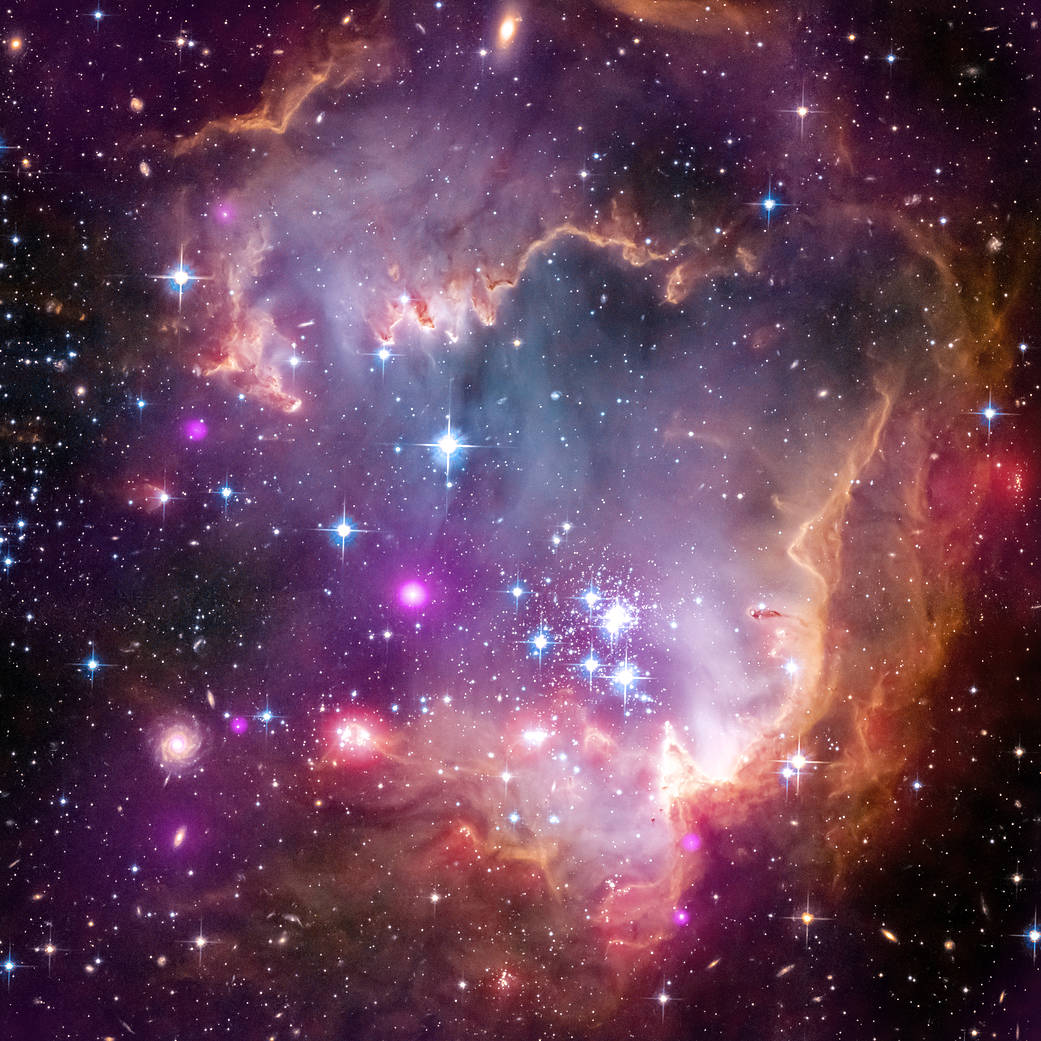NASAの今日の1枚は美しいマゼラン星雲の画像です。
「マゼラン星雲」といいましたが、最近は「マゼラン雲」と言われるのが一般的になってきています。
また用語の区別(使い分け)が厳密化されつつあり「マゼラン銀河」とは言われなくなりつつあります。
NASAの記事でも「The Magellanic Cloud」と書かれていますので、以下は「マゼラン雲」で記載いたします。
ちなみにマゼラン雲は、「大マゼラン雲」(Large Magellanic Cloud = LMC)と「小マゼラン雲」(Small Magellanic Cloud = SMC) の2つの星雲で構成されています。
今日の1枚の画像は「小マゼラン雲」の方になります。
NASA公式サイトのURLはこちら:
Taken Under the ‘Wing’ of the Small Magellanic Cloud | NASA
以下はオリジナル原文と和訳です。
Taken Under the ‘Wing’ of the Small Magellanic Cloud
The tip of the “wing” of the Small Magellanic Cloud galaxy is dazzling in this 2013 view from NASA’s Great Observatories. The Small Magellanic Cloud, or SMC, is a small galaxy about 200,000 light-years way that orbits our own Milky Way spiral galaxy.
小マゼラン雲の銀河の「翼」の先端に当たる部分は、NASAの宇宙望遠鏡群が2013年に観測した画像で見るとまばゆいばかりです。小マゼラン雲(SMC)は、私たちの天の川渦巻銀河を周回する軌道上約20万光年の距離の先に存在する小さな銀河です。
The colors represent wavelengths of light across a broad spectrum. X-rays from NASA’s Chandra X-ray Observatory are shown in purple; visible-light from NASA’s Hubble Space Telescope is colored red, green and blue; and infrared observations from NASA’s Spitzer Space Telescope are also represented in red.
色は、広いスペクトルにわたる光の波長を表します。 NASAのチャンドラX線観測衛星で観測されたX線は紫色で示されています。 NASAのハッブル宇宙望遠鏡から観測された可視光は赤、緑、青で示されています。 NASAのスピッツァー宇宙望遠鏡から観測された赤外線観測も赤で表されています。
The spiral galaxy seen in the lower corner is actually behind this nebula. Other distant galaxies located hundreds of millions of light-years or more away can be seen sprinkled around the edge of the image.
下隅に見える渦巻銀河は、実際にはこの星雲の後ろにあります。数億光年以上離れた場所にある他の遠方の銀河が、画像の端に散らばっているのを見ることができます。
The SMC is one of the Milky Way’s closest galactic neighbors. Even though it is a small, or so-called dwarf galaxy, the SMC is so bright that it is visible to the unaided eye from the Southern Hemisphere and near the equator. Many navigators, including Ferdinand Magellan who lends his name to the SMC, used it to help find their way across the oceans.
小マゼラン雲は、天の川に最も近い位置にある銀河の1つです。小さな、いわゆる矮小銀河ですが、小マゼラン雲は非常に明るいため、南半球や赤道近くからは肉眼で見ることができます。 小マゼラン雲の名前の由来でもあるフェルディナンドマゼランを含む多くの探検家は、星座を観測することで大洋を航海していたのでした。
Modern astronomers are also interested in studying the SMC (and its cousin, the Large Magellanic Cloud), but for very different reasons. Because the SMC is so close and bright, it offers an opportunity to study phenomena that are difficult to examine in more distant galaxies. New Chandra data of the SMC have provided one such discovery: the first detection of X-ray emission from young stars, with masses similar to our sun, outside our Milky Way galaxy.
現代の天文学者も小マゼラン雲(およびそのいとこである大マゼラン雲)の研究に関心を持っていますが、その理由は大きく異なります。 小マゼラン雲はとても近い距離に位置するため、より遠方の銀河では調べるのが難しい天文現象を研究するのに都合が良いのです。 小マゼラン雲に関するチャンドラ観測衛星のデータは、新たな発見を提供しました。それは、天の川銀河の外で、太陽に似た質量を持つ若い星からのX線放射を初めて検出したことです。
Image Credit: NASA/CXC/JPL-Caltech/STScILast
Updated: Feb 5, 2021
Editor: Yvette Smith











